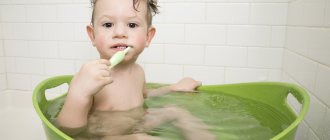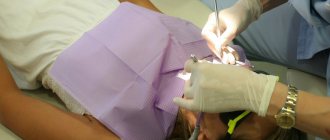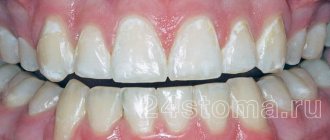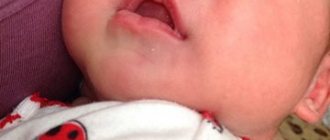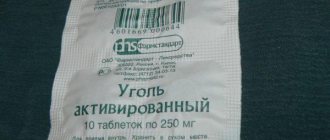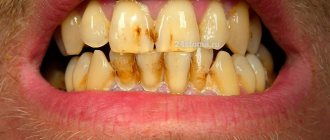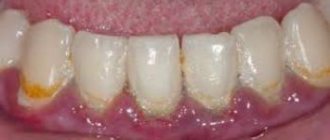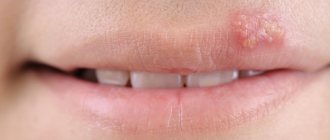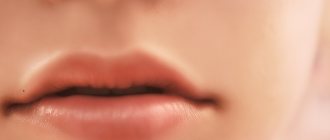Plaque on the teeth of children is a fairly common occurrence, primarily in cases where insufficient attention is paid to oral hygiene. Plaque itself is a collection of food debris, bacteria and elements of the oral mucosa. Initially, it has a soft structure, so removing it from the surface of the teeth is not difficult, but later it quickly hardens and cannot be removed with a simple toothbrush.
Dental plaque varies in color, from almost white to brown and black. The chemical composition of such formations is formed 80% from water, and the rest is formed by fluorides, calcium, phosphorus compounds and other elements.
White spots on a child’s teeth: a simple defect or an alarming symptom
All parents want to see their child happy and healthy. Therefore, it is important to carefully monitor the condition of his body. For any alarming symptoms, a causative factor must be found. Attentive attention to oral health is one of the main conditions for ensuring good health for the baby. If you notice white spots on your child's teeth, there is no need to panic, but you should not let the problem take its course. More often it indicates the beginning of the development of caries, but it can also manifest itself for other reasons. The dentist will help you cope with the problem.
Additional protective measures for Priestley's raid
It is possible that Priestley's plaque on the teeth appeared due to an infection and, as a result, a temporary deterioration in the functioning of the immune system. But it is necessary to make sure that there are no serious and dangerous deviations in the child’s health. Therefore, if dental plaque is detected, the dentist will recommend taking additional measures:
- get tested for the presence of parasites in the body;
- consult a gastroenterologist;
- take tests to check the level of iron and calcium in the body;
- check your blood sugar levels.
These measures will help identify the problems that are causing plaque to form on your teeth.
White spots on enamel: what are they?
More often, white spots appear on baby teeth, less often on permanent teeth. Experts divide them into two classes:
- carious - those that are associated with the development of caries;
- non-carious.
White areas on the enamel indicate its demineralization. A whitish line may also appear at the edge of the gums of the front teeth. In any case, consultation with a doctor is required.
Compared to permanent teeth, baby teeth are more susceptible to caries. Their enamel is thin and porous, which allows bacteria to easily penetrate inside. The disease progresses quickly, so in a short period of time there may be nothing left of the tooth. There is a risk of damage to the “successor” rudiments. These facts refute the opinion of some parents that there is no need to treat baby teeth, since they must be replaced.
Is it possible to remove plaque at home?
Try to cope with the help of traditional medicine recipes. But at the same time, you must be 100 percent sure that the child does not have carious lesions, otherwise severe pain will arise, and you will have to run to the dentist immediately, abandoning everything.
Methods that are relatively safe for children's teeth are as follows.
Activated carbon
Take a tablet of activated carbon, crush it to a powdery state, add a couple of drops of water with a pipette and apply the mixture to the brush. Let the child brush his teeth with the product, then rinse his mouth and use hygiene paste.
If the plaque disappears, it means there are no carious cavities yet. In the future, maintain good hygiene.
Lemon
Cut a piece of lemon and press the slice to the child’s teeth, you can rub it lightly. The soft coating is removed. But the baby may not like the specific taste of lemon.
Strawberry puree
Mash fresh strawberries to a puree and apply with your finger to the child’s teeth. Thanks to the presence of fruit acids, the berry copes with plaque. But she can’t handle a hard coating.
You can use strawberries instead of strawberries.
Carious lesions
Caries is the most common dental disease. It is usually caused by poor oral hygiene. A white spot on the enamel is the initial stage of the carious process, which is easy to treat and does not require the use of equipment that is so scary for a child, such as a drill. If you palpate the problem area, you may feel roughness. By postponing a visit to the dentist, the enamel in the affected area becomes thinner, softens and begins to deteriorate.
Let's sum it up
White spots on growing children's teeth do not always indicate the presence of a pathological process. Despite the positive statistics, you should not do anything on your own or self-medicate without consulting a doctor. You cannot delay a visit to the dental clinic, because it is much easier to get rid of the problem at the initial stage than in advanced cases associated with deep damage.
Sometimes light spots on the enamel indicate serious systemic pathologies, and a simple examination by a dentist will not be enough. Additional tests and advice from specialists will be needed.
By following preventive rules, you can prevent the appearance of light spots. It is important to teach your child to regularly care for his mouth and periodically show him to the dentist.
Excess or lack of fluoride
Fluoride is an element important for teeth, which largely enters the human body with water. It is also found in toothpastes, some foods and polluted air. Excessive intake of fluoride provokes the development of a disease called fluorosis, one of the symptoms of which is white or yellow spots on the enamel. They are often subtle and are identified when visiting a doctor. The coloring of defects may be uneven.
Baby teeth are more susceptible to disease. The appearance of permanent ones reduces the risk of developing fluorosis. Children with chronic diseases and weakened immunity are also at risk.
Fluoride deficiency is also harmful to teeth. In this case, they become vulnerable, which causes tooth decay and gum disease.
Plaque turns brown
This is evidence of sediment mineralization. Most likely, they became hard and turned into tartar.
The stone is formed from the inside, but can also be found on the outside. You cannot deal with it on your own: the dentist is working to remove such plaque.
If you see not only dark plaque on your baby’s teeth, but also small irregularities, dots, and shading, it is likely that the child has fluorosis.
It is caused by excess fluoride. They are treated with specially selected fluoride-free pastes and drinking water passed through a filter. Only a doctor can make a diagnosis.
Enamel hypoplasia
We are talking about severe thinning, partial or complete absence of enamel. Hypoplasia is a disease that manifests itself not only in the form of whitish spots, but also grooves and depressions on the tooth surface. It can be triggered by various factors:
- infectious diseases during pregnancy;
- Rh conflict between mother and fetus;
- premature birth;
- birth injury;
- taking certain illicit drugs by a pregnant woman;
- disturbances in the functioning of the endocrine, nervous systems or gastrointestinal tract.
The pathology is accompanied by increased sensitivity of teeth to irritants and caries.
The main dangers of dental plaque
Such deposits, regardless of their color, are a breeding ground for various bacteria, so they pose a danger to the child and require prompt removal. At the same time, the waste products of such microorganisms have an acidic environment, which has a destructive effect on tooth enamel.
In this case, the following diseases may become further development of plaque:
- Destruction of enamel;
- Formation of tartar;
- Caries;
- Gingivitis (inflammation of gum tissue);
- Periodontitis.
How can a specialist help?
To determine the cause of the problem, you need to contact your dentist. He will conduct a visual examination, assess the size of the spots, the degree of enamel destruction, and the number of teeth involved in the painful process. In the initial stages of caries, remineralization and fluoridation help. If the disease has affected the deeper structures of the tooth, you cannot do without using a drill and filling.
If whitish spots occur while wearing braces or other orthodontic construction, a comprehensive approach is taken to solving the problem:
- treat caries;
- carry out disinfection;
- replace corrective devices with new ones;
- carry out professional cleaning to remove plaque.
In some cases, the help of highly specialized specialists may be needed (if the doctor rules out dental pathologies).
Signs and causes of plaque formation
It is difficult not to notice the appearance of soft and hard deposits on the teeth. Moreover, the process is accompanied by the following phenomena:
- change in enamel color and loss of shine;
- surface roughness;
- the appearance of bad breath.
During a consultation, the dentist can assess the negative impact of deposits on the general condition of the oral cavity based on the following factors: the depth of periodontal pockets, the intensity of gum bleeding, and tooth mobility.
Causes of dental plaque:
- insufficient oral hygiene, including when correcting bites with braces;
- lack of solid foods in the diet and the predominance of easily digestible carbohydrates;
- smoking;
- gastrointestinal diseases and metabolic disorders;
- hereditary factor;
- taking certain medications and iron supplements;
- climate change;
- age-related demineralization of enamel.
Eliminating white spots on teeth: what you can do at home
If the problem lies in an excess or deficiency of fluoride, you may need to change the water or install a filter that will remove this element. For fluorosis, toothpastes purchased for a child should not contain fluoride.
If a child is one year old and already has white spots on his teeth, his diet needs to be adjusted. It is important that in addition to breast milk, the diet contains foods containing calcium and vitamins, such as cottage cheese and vegetables. If the baby is on artificial nutrition, you should make sure that he does not fall asleep with a bottle in his mouth. Remains of sweet milk formula can trigger the development of so-called bottle caries.
It is also necessary to pay great attention to oral hygiene. Parents should take care of their teeth first. And when the baby becomes more independent, you need to teach him the basic rules of hygiene. Your doctor will also give you recommendations for care.
Traditional methods of treatment
Adherents of “grandmother’s” methods should resort to them only in cases where the contrasting white spots on the child’s teeth are purely a cosmetic defect and the doctor gives instructions for treatment at home. For example, you can rinse your mouth with a weak solution of table vinegar (2 teaspoons of the substance per 1 spoon of salt and a glass of clean boiled water). This way you can get rid of plaque and restore the balance of minerals. The only disadvantage of this product is that the baby may swallow it out of curiosity or accidentally, so this method is recommended for older children.
There is also a safer strengthening composition for enamel. We are talking about green tea. It contains flavonoids, as well as gallic and chlorogenic acids. With regular drinking of the drink, pigmentation will completely disappear. In addition, the condition of the mucous membranes in the mouth will significantly improve.
Preventive measures
It is important to provide your child with proper dental care. Immediately after the first incisor appears on an infant, it is necessary to thoroughly clean it with a special brush-finger 2 times a day. It is necessary to ensure proper oral care even before teething begins. For this purpose, wipe the gums with a sterile piece of gauze soaked in boiled water. Other preventative measures:
- limiting the consumption of sweets, confectionery, carbohydrate foods, acidic foods and drinks;
- regularly visit the dentist with your child - at least 2 times a year, ideally - every 3-4 months;
- Give your baby vitamin complexes after illnesses and during periods of active growth - only as prescribed by the pediatrician.
It is important for the expectant mother to follow a diet and not take medications without the doctor’s approval.
Disease prevention
Preventive measures to prevent the development of dental diseases and the formation of plaque should be applied from the moment the baby first starts teething. The risk of unpleasant problems occurring can be significantly reduced by the following simple measures:
- Gentle oral care . Infants up to one year old can clean their gums with a cotton pad soaked in a decoction of chamomile, string, oak bark or sage. Special silicone attachments are also widely popular, which adults put on their fingers and thus clean the baby’s oral cavity. From the age of two, children must be taught to brush their teeth with a brush and toothpaste, and it is also advisable to rinse the mouth after each meal.
- Proper nutrition. This does not imply following any diets, but the child’s nutritional system should be designed in such a way as to limit his intake of sweets, sugar, confectionery and increase the consumption of healthy natural products. Sweets from the store are an excellent substitute for candied fruits, fruits and dried fruits.
- Timely abandonment of pacifiers and bottles. With prolonged use of a bottle or pacifier, an incorrect bite develops, dependence on accessories appears, and a black plaque forms, which in dentistry is called “bottle caries.” You should not delay in weaning your child off devices that he no longer needs.
- Maintaining the immune system. It is important to ensure that even in winter, the child has enough vitamins to maintain healthy teeth and the body as a whole.
By following these simple recommendations, you will ensure your child’s dental health and the beauty of a child’s smile.
Products that improve enamel color
To help prevent darkening of your teeth:
- nuts (contain vitamins necessary for the proper formation of enamel);
- apples and pears (contain fruit acids and water);
- strawberries, wild strawberries (have whitening properties);
- broccoli (removes dark colored deposits).
As soon as the child's teeth have formed, he must be gradually introduced to solid food. Let him nibble on carrots and green apples: in addition to saturating the body with vitamins, they help clean off soft deposits.
Give your child more dairy products. But sweets should be limited: they create an excellent breeding ground for bacteria.
Yellow plaque in children
If yellow plaque has already formed, this means that the microflora of the oral cavity is favorable for the formation of pathogenic bacteria. In order for yellow plaque to form more slowly, you need to brush your teeth twice every day with your child - in the morning and in the evening, before bed. Be sure to supervise the process of brushing your teeth and help your child brush his teeth in hard-to-reach places; to determine and visualize dental plaque, use a plaque indicator in the form of tablets or elixir dyes.
You can also print out our brushing calendar to make the process more fun.
